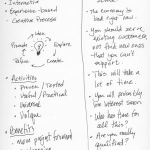It’s time to create some new content. I’m pretty good at this. After all, I’m a professional. And if I can’t come up with something powerful, useful, and fantastic, then I shouldn’t be doing this at all. Let’s face it, this better be good.
If the above conversation feels vaguely familiar, it’s probably because you have been doing something creative, something that matters, something people need. And creative work like this often surfaces the voices of the Saboteur.
Hearing Voices
These voices are the ones that tell you to not take any risks, to play it safe, to stay with the status quo. They remind you of the dangers of both success and failure, and try to keep you from individuality, passion, and powerful creativity.
Deconstructing “Better Be Good”
The Saboteur voices come in many shapes and sizes. Let’s take a close look at this particular one. It’s crafty. On the surface it appears to want the best for me (using words like professional, excellent, powerful, useful). But notice the focus of attention: it’s a lot about me, my credentials, and living up to expectations. That’s a lot of pressure for someone trying to make something that wasn’t there before.
Dealing with Voices
In coaching, we use several techniques for dealing with these voices. For now, let’s just look at one. I call it “simply noticing.” With this technique, you just notice when you hear these voices, and then you write down what they say. I usually create a separate column in my journal for these voices so I don’t confuse them with thoughts of my own. And once I write them down, I go back to creating. That’s it. Simple. No conversations, no back-and-forth arguments. Just notice and record.
Why It Works
The Saboteur has never actually created anything. And all he wants is to be heard. And if the voice is persistent, then there is probably some truth in there somewhere. Writing it down is a way of hearing the voice and finding the kernel of truth in it. And once it’s on paper, there is no need to keep it in my mind because I already have it stored over there. Now my mind is free to continue creating something I care about. I can always go back and consider it again later, maybe after I finish this draft. Usually I don’t even go back to the journal because I’m so excited about what I’ve just created.
Now You
Do you hear Saboteur voices when you sit down to create? What do they say? How do you deal with them? There are lots of techniques—this is just one that you might play with. Don’t let the voices stop you. And don’t worry about making something fantastic. Make what seems right for now. You can always go back and tweak it later.
Update: If you have 20 minutes, watch this video. It’s Jack Conte from Pomplamoose explaining how he got trapped by the “This Better Be Good” gremlin and how he got untrapped (from XOXO Festival 2013):
